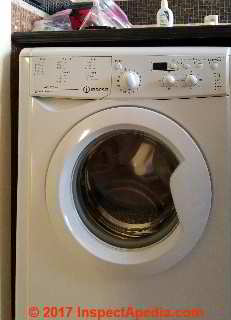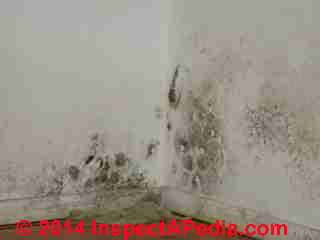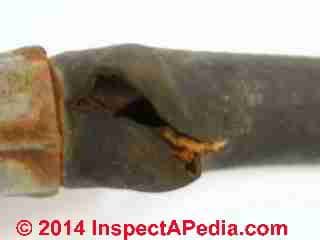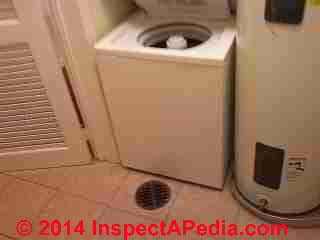 Washing Machine Water Leaks
Washing Machine Water Leaks
Causes &
Repair of leaks at clothes washers
- POST a QUESTION or COMMENT about clothes washing machine repairs
Washing machine leak repairs:
This article describes water leak causes at washing machines. We discuss where leak may be coming from and where washing machine water leaks show up.
We describe basic tests of the washer water level control or sensor switch and basic tests of the washing machine water inlet solenoid valve.
Here we also warn about building flooding and mold contamination that can result if a washer hose bursts while no one is at home. Links are included to related appliance diagnostic and repair procedures.
InspectAPedia tolerates no conflicts of interest. We have no relationship with advertisers, products, or services discussed at this website.
- Daniel Friedman, Publisher/Editor/Author - See WHO ARE WE?
How to Diagnose & Repair Washing Machine Oil or Grease Leaks
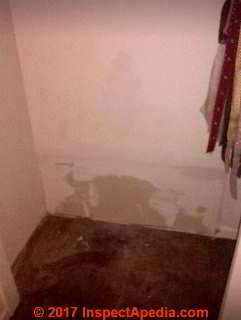 Reader Question: can over-stuffing a washing machine cause it to leak into the wall?
Reader Question: can over-stuffing a washing machine cause it to leak into the wall?
I moved in to a brand new apartment and had a plumbing leak within the wall. The plumbing was for the washer and bathroom. You were able to see that the leak was about half way up the wall.
Could an internal wall plumbing leak for supply and drain for washer and bathroom be caused by over stuffing the washer? It is my understanding that if a washer was overstuffed that the leak would be on the floor where machine is located.
I was told the leak was caused possibly by the pipes being too small to handle the pressure or a leak in the pipes or fittings.
Here is a photo of the wall. It’s the common wall between my bedroom closet and the laundry room. - Anonymous by private email 2017/12/19
Reply: common oil leak points at clothes washing machines
In your photograph the cut-out area looks low enough that a washer drain leak could have occurred in the wall. Typically that would be due to a clogged drain or improper drain-venting.
Bottom line: I do not understand any scenario in which over-loading a washing machine with too much clothing would cause a leak back inside the wall where you report the leak has occurred. And a washer leak that causes the machine's tub or drum to overflow would wet the floor and the bottoms of nearby walls. It wouldn't wet just one wall.
Causes of washing machine leaks and spills:
Most washing machines control the water level in the tub by a combination of a switch, slider, or control setting on the washing machine. That control in turn communicates with a washing machine fill-level sensor switch in the machine. That switch reacts to water level. It's usually a simple pressure sensor. The fill level switch in a clothes washer responds to the level of water in the machine, not the level of clothing. (It doesn't care about the clothing level, but of course if you put in too much clothing for a too-low water level setting the clothes may not wash thoroughly.)
Top Loading Washer Overflows & Spills
When a washing machine overflows at the top of its tub it's usually because of using too much detergent - suds rise too high and flow over - or the washer's own overflow tube is clogged.
If a washing machine is overloaded with clothing it's possible for some clothes to bulge up higher than the edges of the tub - that might cause some spillage during the agitation cycle if water sloshes over the drum edge.
In such cases I'd expect an appliance repairperson to check that the washing machine's fill-limit-sensor switch is working properly - not over-filling the drum. So a bad fill-limit switch could cause an overflow.
A bad fill control switch - separate from a fill limit switch on some washers, might over-fill the washer leading to spills. A fill switch can get stuck in the open position (rare).
A bad fill switch or fill limit switch on a washing machine is likely to cause the over-fill problem to occur repeatedly. So if your spill-over happened only once the switch may not be the culprit.
It's also possible that overloading might cause the tub to wobble out of balance during the spin cycle. Some splash over could occur during such wobbling before the washer switches off (due to an out of balance sensor) as most will do when the drum is unbalanced.
Even if a washing machine tub overflowed because of some operational problem you'd have seen a wet floor below the machine and wet walls near the floor on all sides of the wet floor area.
Front-Loading Washing Machine Overflows & Spills
To the above I'd add:
Over-loading a front-loading washing machine might cause an out-of-balance condition in the drum that in turn causes a dislocation and lost drum seal (rare).
The most-common causes of washing machine leaks
- cracks or breaks in the water supply hoses to the washer
- a clogged or improperly-vented or under-sized washing machine drain
- too much detergent or wrong type of detergent (do not use a high-sudsing detergent like dish soap)
If someone offers you a more-clear explanation for the over-stuffed claim I'd be interested in learning about it.
[Click to enlarge any image]
Reply: the causes of washing machine water leaks and overflows & where leaks appear
In your photograph the cut-out area looks low enough that a washer drain leak could have occurred in the wall. Typically that would be due to a clogged drain or improper drain-venting.
Bottom line:
I do not understand any scenario in which over-loading a washing machine with too much clothing would cause a leak back inside the wall where you report the leak has occurred. And a washer leak that causes the machine's tub or drum to overflow would wet the floor and the bottoms of nearby walls. It wouldn't wet just one wall.
[If your washing machine is leaking oil, not water, see WASHING MACHINE OIL LEAKS]
Causes of washing machine leaks and spills:
Top Loading Washer Overflows & Spills
When a washing machine overflows at the top of its tub it's usually because of using too much detergent - suds rise too high and flow over - or the washer's own overflow tube is clogged.
If a washing machine is overloaded with clothing it's possible for some clothes to bulge up higher than the edges of the tub - that might cause some spillage during the agitation cycle if water sloshes over the drum edge.
In such cases I'd expect an appliance repair person to check that the washing machine's fill-limit-sensor switch is working properly - not over-filling the drum.
Overloading and balance problems at a washing machine
It's also possible that overloading might cause the tub to wobble out of balance during the spin cycle. Some splash over could occur during such wobbling before the washer switches off (due to an out of balance sensor) as most will do when the drum is unbalanced.
Even if a washing machine tub overflowed because of some operational problem you'd have seen a wet floor below the machine and wet walls near the floor on all sides of the wet floor area.
Front-Loading Washing Machine Overflows & Spills
Over-loading a front-loading washing machine might cause an out-of-balance condition in the drum that in turn causes a dislocation and lost drum seal (rare).
The most-common causes of washing machine leaks
- Cracks or breaks in the water supply hoses to the washer
- A clogged or improperly-vented or under-sized washing machine drain
- Too much detergent or wrong type of detergent (do not use a high-sudsing detergent like dish soap)
If someone offers you a more-clear explanation for the claim that over-filling a washing machine causes it to leak in the wall cavity behind the washer I'd be interested in learning about it
Photo: a compact, front loading washing machine in an apartment in Campo San Maurizio, Venice, Italy.
Role of Washing Machine Fill Switch in Overflows & Leaks
Most washing machines control the water level in the tub by a combination of a switch, slider, or control setting on the washing machine. That control in turn communicates with a washing machine fill-level sensor switch in the machine. That switch reacts to water level. It's usually a simple pressure sensor.
The fill level switch in a clothes washer responds to the level of water in the machine, not the level of clothing. It doesn't care about the clothing level, but of course if you put in too much clothing for a too-low water level setting the clothes may not wash thoroughly.
Our illustration below uses a Sears water level pressure switch # WPW10268911 to illustrate this control. This and other washing machine repair parts are available from Sears Parts Direct as well as from other suppliers. Some of these water level controls are interchangeable among a number of brands and models.
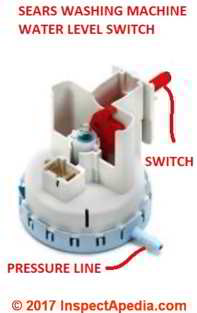 For example the Whirlpool-brand W10339334 Washer Water level Pressure Switch replaces pressure switch model #s 1636739, 8577845, AP4568374, W10213199, W10339330 and serves washing machines sold under these brands: Admiral, Amana, Crosley, Estate,KitchenAid, Roper, Inglis, Magic Chef, Maytag, as well as Whirlpool brand washers.
For example the Whirlpool-brand W10339334 Washer Water level Pressure Switch replaces pressure switch model #s 1636739, 8577845, AP4568374, W10213199, W10339330 and serves washing machines sold under these brands: Admiral, Amana, Crosley, Estate,KitchenAid, Roper, Inglis, Magic Chef, Maytag, as well as Whirlpool brand washers.
On a typical washing machine water level control, a mechanical switch (red in our illustration) allows the homeowner to set the desired water level in the washing machine.
Check the water level tube:
A plastic tube (not shown) conducts water pressure from a sensor port usually on the side of the washing machine drum or tub up to the pressure line connector (light blue in our illustration) on the level switch.
As water enters the washing machine tub it pressurizes air in the sensor tube that in turn communicates that pressure to the control.
When the water-pressure indicates the desired water level the switch stops water from entering the washing machine tub. It does this by opening an electrical switch that in turn connects to the washing machine timer and washing machine water valve. The water valve, operated by an electrical solenoid switch, closes to stop water from entering the washing machine.
A bad fill-limit switch a leaky, disconnected, clogged, or kinked pressure tube between the washer tub and the control could cause over-filling and then a water overflow at a washing machine.
Check the water level control electrical switch:
A bad washing machine water level switch might fail to open or close the electrical connection to the timer in response to water pressure. Among the three terminals on the switch you should find a resistance reading (using a VOM or DMM) close to either infinity (the switch is open) or close to zero (the switch is closed).
One pair of contacts should be open and the other pair should be closed. If not the switch may be defective.
Watch out: do not attempt electrical tests unless you are trained and comfortable doing so safely. You could be shocked or killed. See DMMs VOMs SAFE USE OF.
Watch out: before removing wires from a control to permit testing be sure to take a photo, make a sketch, or label the wires and connection points so that you can re- make the connections correctly afterwards.
A bad fill switch or fill limit switch on a washing machine is likely to cause the over-fill problem to occur repeatedly. So if your spill-over happened only once the switch may not be the culprit.
Role of the Washing Machine Water Inlet Valve / Solenoid in Washer Overflows
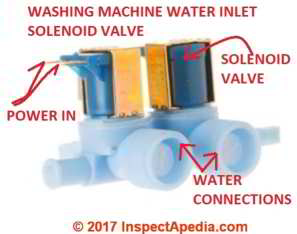 If the solenoid-operated water inlet valve is stuck or not working properly that too can over-fill a washing machine.
If the solenoid-operated water inlet valve is stuck or not working properly that too can over-fill a washing machine.
Above: a clothes washer water inlet solenoid valve, illustration adapted from Sears PartsDirect
Watch out: some washer solenoid valves often operate at 120VAC. Do not disassemble, open, or touch electrical components when electrical power is connected to the washing machine. You could be shocked or4 killed.
If the washer water inlet valve is working properly it will open or close in response to voltage. There are two solenoids, one each to control cold water and hot water inlets respectively. Each solenoid valve is opened or closed by an electromagnet that in turn is fed power from the washing machine's electrical controls.
If you remove the power connections from the solenoid, your VOM set to the lowest ohms range (Ohms x 1 on most meters) should indicate some electrical resistance (greater than 1 Ohm).
So if there is in effect no resistance (reading 0-1 ohms) the valve is defective - replace it with an OEM or equivalent valve.
As with a bad pressure sensor / fill level switch, a bad inlet valve can also flood the washer: you will see that the washing machine, once turned-on, begins to fill and simply continues to fill without stopping.
Risk of Costly Building Water Damage or Mold Contamination from Washing Machine Leaks
Watch out: for leaky or worn washing machine hoses connected to the water supply. Leaving home without turning off water supply to the washer can mean you return to a flooded building if one of these hoses bursts.
Our moldy drywall (and clump of clothes dryer lint) above was caused by a small leak at a washing machine.
Our second photo (below) shows a burst washing machine hose. This washer hose broke open when the building owners were out of town. The un-attended home was flooded and suffered extensive and expensive mold contamination discovered a week later when the homeowners returned.
...
Continue reading at WASHING MACHINES & SEPTIC SYSTEMS or select a topic from the closely-related articles below, or see the complete ARTICLE INDEX.
Or see these
Reommended Articles
- APPLIANCE DIAGNOSIS & REPAIR
- CROSS CONNECTIONS, PLUMBING
- DRYWELL DESIGN & USES.
- GREYWATER SYSTEMS
- WASHING MACHINE LEAKS
- WASHING MACHINE NOISE CAUSE & CURE
- WASHING MACHINE OIL LEAKS
- WASHING MACHINES & SEPTIC SYSTEMS
Suggested citation for this web page
WASHING MACHINE LEAKS at InspectApedia.com - online encyclopedia of building & environmental inspection, testing, diagnosis, repair, & problem prevention advice.
Or see this
INDEX to RELATED ARTICLES: ARTICLE INDEX to APPLIANCE REPAIR
Or use the SEARCH BOX found below to Ask a Question or Search InspectApedia
Ask a Question or Search InspectApedia
Try the search box just below, or if you prefer, post a question or comment in the Comments box below and we will respond promptly.
Search the InspectApedia website
Note: appearance of your Comment below may be delayed: if your comment contains an image, photograph, web link, or text that looks to the software as if it might be a web link, your posting will appear after it has been approved by a moderator. Apologies for the delay.
Only one image can be added per comment but you can post as many comments, and therefore images, as you like.
You will not receive a notification when a response to your question has been posted.
Please bookmark this page to make it easy for you to check back for our response.
IF above you see "Comment Form is loading comments..." then COMMENT BOX - countable.ca / bawkbox.com IS NOT WORKING.
In any case you are welcome to send an email directly to us at InspectApedia.com at editor@inspectApedia.com
We'll reply to you directly. Please help us help you by noting, in your email, the URL of the InspectApedia page where you wanted to comment.
Citations & References
In addition to any citations in the article above, a full list is available on request.
- John Cranor [Website: /www.house-whisperer.com ] , ASHI certified home inspector (house-whisperer.com) in Richmond, VA, can be reached by email to: johncranor@verizon.net or by telephone at 804-873-8534. Technical review, email, 1/2012
- [1] Heartland 21000 Dryer Vent Enclosure
- [1] Lambro Industries 289W Dryer Vent Enclosure
- [1] Fantech Dryer Booster Lint Trap - Fantech Model DBLT 4
- [2] "Overheated Clothes Dryers Can Cause Fires, CPSC Document # 5022 Updated June 2003", U.S. Consumer Product Safety Commission, www.cpsc.gov., websearch 11/25/2011, original source: cpsc.gov/cpscpub/pubs/5022.html
- [3] "Electric and Gas Clothes Dryers, Staff Evaluation and Contractor Report", US CPSC Memorandum, 25 Feb 2000
- [4]"Report on Electric and Gas Clothes Dryers", U.S. CPSC Memorandum, 25 Feb 1999, the Clothes Dryer Project, March 1999
- [5] UL Standard 2158, voluntary standard for electric clothes dryers
- [6] ANSI Z21.5 1 (CGA 7.1) voluntary safety standard for gas powered clothes dryers
- [7] "Healthy Indoor Air for America's Homes, Indoor Air Hazards Every Homeowner Should Know About - room by room assessment", U.S. Government Publications, web search, 11/30/2011, original source: http://publications.usa.gov/epublications/indoorair-hazards/assessment.htm More about this information source, quoting the US Government website:
... Federal Citizen Information Center (FCIC) has been a trusted one-stop source for answers to questions about consumer problems and government services. FCIC, part of the General Services Administration's Office of Citizen Services and Innovative Technologies, has traditionally provided publications to consumers via the publications distribution center in Pueblo, Colorado. The Pueblo.GSA.gov website was where consumers could go to find information and order publications on a variety of topics from the federal government.
Publications.USA.gov replaces the former Pueblo.GSA.gov. - [8] "The Facts About Clothes Dryer Exhaust Systems", John Cranor, the ASHI Reporter, April 2005,American Society of Home Inspectors,® Inc., 932 Lee Street, Suite 101, Des Plaines, Illinois, 60016, Tel: 847-759-2820, website: ashi.org, original source: ashireporter.org/articles/articles.aspx?id=161
- [9] Tjernlund Residential Capacity Dryer Duct Booster®, "Dryer Duct Booster Fan Model LB1, Installation Instructions" [PDF], Tjernlund Products, 1601 9th Street
White Bear Lake, MN 55110-6794 , (800) 255-4208, web search 01/06/2012, original source: tjernlund.com/dryer_booster.htm Quoting:
The Dryer Duct Booster®, Model LB1, has been specifically designed to boost residential capacity clothes dryer duct exhaust velocities where dryer duct runs exceed 25 equivalent feet. Proper exhaust velocities will reduce drying times, save energy and prevent lint buildup in the dryer duct. The LB1 is controlled by an electronic Pressure Response Control (PRC) for automatic operation. The LB1 utilizes galvanized steel construction, a reverse inclined, particulate handling impeller that is guaranteed not to clog with lint and an externally mounted PSC motor for trouble-free operation. - "About the House - Bathroom Vents", Henri deMarne, New England Builder, November 1985
- "Bathroom Vent Fan Beats Open Window", James Dulley, Poughkeepsie Journal, 11/4/1987 p. 12D.
- Our recommended books about building & mechanical systems design, inspection, problem diagnosis, and repair, and about indoor environment and IAQ testing, diagnosis, and cleanup are at the InspectAPedia Bookstore. Also see our Book Reviews - InspectAPedia.
- In addition to citations & references found in this article, see the research citations given at the end of the related articles found at our suggested
CONTINUE READING or RECOMMENDED ARTICLES.
- Carson, Dunlop & Associates Ltd., 120 Carlton Street Suite 407, Toronto ON M5A 4K2. Tel: (416) 964-9415 1-800-268-7070 Email: info@carsondunlop.com. Alan Carson is a past president of ASHI, the American Society of Home Inspectors.
Thanks to Alan Carson and Bob Dunlop, for permission for InspectAPedia to use text excerpts from The HOME REFERENCE BOOK - the Encyclopedia of Homes and to use illustrations from The ILLUSTRATED HOME .
Carson Dunlop Associates provides extensive home inspection education and report writing material. In gratitude we provide links to tsome Carson Dunlop Associates products and services.


